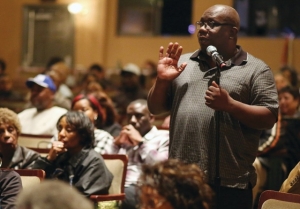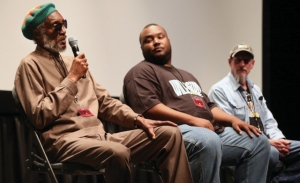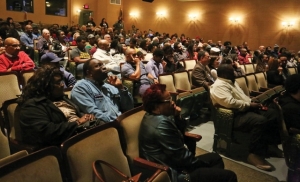'Wilmington on Fire' sparks discussion
By John Joyce
Published in News on February 3, 2016 1:46 PM

News-Argus/CASEY MOZINGO
Maurice Nicholson asks the stars and creator of "Wilmington on Fire" what kind of difficulties they experienced in the making of the documentary during a panel discussion after the screening.

News-Argus/CASEY MOZINGO
Larry Reni Thomas answers a question during a panel discussion after the screening of "Wilmington on Fire" Monday night at the Paramount Theatre. Joining Thomas on stage was Chris Everette, the documentary's creator, and Kent Chatfield, another star of the film.

News-Argus/CASEY MOZINGO
A crowd of people gathered to watch a screening of "Wilmington on Fire" at the Paramount Theatre Monday night. Attendees were invited to stay after the screening of the documentary to ask questions.
Writer and director Christopher Everette, whose documentary film "Wilmington on Fire" played before a 247-person audience at Goldsboro's Paramount Theatre Monday, will return in March for a second showing.
Everette said he was moved by the audience's reaction to his historical account of the 1898 Wilmington massacre.
"I loved it. I would come in an out and people were laughing and clapping. I didn't see anyone leave, so I guess that is a good thing," he said.
His film has sold out at several college campuses and at a Wilmington film festival.
Friday, the filmmaker travels to Durham to share his film at the Hayti Heritage Center. But it was mid-show Monday night that Everette decided, based on the turnout and on the crowd's rapt attention, he would schedule a second date.
"He asked if he could come back and we said, 'Of course,'" Paramount director Sherry Archibald said.
"Wilmington on Fire" returns March 29 to the Paramount Theatre at 7 p.m. Tickets are on sale now.
Following the 120-minute film, which combines anecdotes from descendants of the actual victims with historical documentation and photos of the destruction, Everette and two of the film's contributors sat on stage for a question and answer period. Goldsboro native and community activist, author and entrepreneur Yasheeka Sutton emceed the affair.
Prior to the film, Ms. Sutton told the audience the content would leave them thinking differently in terms of progression versus victimization.
"Ain't no victims in here," she said. "We are survivors."
Wilmington native and author Larry Renni Thomas and fellow Wilmington native and researcher Kent Chatfield, joined Everette on stage.
Both men are featured in the film and contributed largely to the historical record that Everette drew from to produce the picture.
"It is crucial history that you need to know about," Thomas said.
He began looking into the Wilmington massacre as a grad student at the University of North Carolina in the late 1970s. Thomas began his graduate thesis on the Wilmington 10 -- a group of men arrested during the civil rights movement for staging a protest -- but was encouraged by a professor to shift his paper's focus.
"What he told me is, it wasn't history yet," Thomas said. Thomas decided to investigate what led up to the Wilmington 10 to begin with. What he found was 1898.
"In the process, I found out that Wilmington was almost an epidemic in terms of racial violence. There were five riots there during reconstruction. And there was an incident that happened during the Nat Turner insurrection of 1831 where some local blacks were accused of insurrection and they were killed ...," Thomas said. "It is a very racially charged place."
Chatfield, too, stumbled backward into 1898. But his "adventure," as he calls it, began at the age of 7.
"I found the unmarked grave of a Confederate soldier and I exhumed his bones. I turned them over to the New Hanover county museum," Chatfield said.
The Wilmington newspaper, The Star News, featured young Chatfield's accomplishment, which resulted in his being summoned to the Wilmington Light Infantry -- a sort of lodge for the descendants of Confederate soldiers. Chatfield said the men there knew of the Confederate soldier, an officer, and they knew about 1898. The men shared stories about the massacre they suggested were true and accurate accounts passed down from their parents and grandparents.
A lot of the names, dates, records and some of the weaponry used in the massacre remained there, Chatfield said. Both the Wilminbgton Light Infantry and the Star News feature prominently in the film.
But there was more to the story.
Once he began to dig -- he recovered documents with one phone call an entire government committee commissioned to report on the massacre was unable to locate -- Chatfield learned the web of lies went deeper and deeper. The massacre, he learned, had more to do with a government coup and a land-grab than it did with matters of race or intermingling of the sexes.
"Traitors," Chatfield calls the men of the Light Infantry in one scene of the film, to which the audience at the Paramount Monday night erupted into applause.
For more on the history of the Wilmington Riot -- or massacre -- of 1898, purchase tickets online or in person for the March 29 show at the Paramount Theatre in Goldsboro.
Everette, who is already working on a follow-up to the film, as well as a martial arts documentary, said he is more than satisfied with the way the film turned out.
"It took about five years to do the film, but I am happy with the results."
